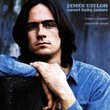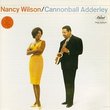| All Artists: Einojuhani Rautavaara, Hannu Lintu, Royal Scottish National Orchestra, Laura Mikkola Title: Rautavaara: Cantus Articus; Piano Concerto; Symphony No. 3 Members Wishing: 0 Total Copies: 0 Label: Naxos Release Date: 3/9/1999 Genre: Classical Styles: Forms & Genres, Concertos, Historical Periods, Modern, 20th, & 21st Century, Instruments, Keyboard, Symphonies Number of Discs: 1 SwapaCD Credits: 1 UPC: 636943414729 |
Search - Einojuhani Rautavaara, Hannu Lintu, Royal Scottish National Orchestra :: Rautavaara: Cantus Articus; Piano Concerto; Symphony No. 3
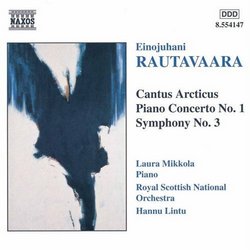 | Einojuhani Rautavaara, Hannu Lintu, Royal Scottish National Orchestra Rautavaara: Cantus Articus; Piano Concerto; Symphony No. 3 Genre: Classical
|
Larger Image |
CD DetailsSimilarly Requested CDs
|
CD ReviewsThe most accessible postmodern music I've ever heard! Bob Zeidler | Charlton, MA United States | 06/25/2000 (5 out of 5 stars) "This album has been revelatory to me, and I came by its existence quite by accident. Had I relied on my "usual sources" - music critics and reviewers in the trade press - I would surely still be without it. It came highly recommended by friends at a music chat room (the Classical Music Forum at the N. Y. Times website), and I pass this recommendation on to all browsers who happen across this review. Einojuhani Rautavaara may well turn out to be a, if not the most, significant composer in the last quarter century. Hand-picked by Jean Sibelius to be his successor, Rautavaara came to the U.S. to study at Julliard and to rub elbows with the likes of Copland, Persichetti and others. He then went on to study at the Darmstadt School, all the while building an early repertoire. If the thought of the Darmstadt School, and its preoccupation with serialism, sounds offputting, permit me to put your mind at ease. The three pieces on this album represent Rautavaara at perhaps early mid-career, covering the period from about 1960 to 1972. (He is still actively - and happily - composing, having recently attended the premiere of his 8th Symphony in Philadelphia.) Cantus Arcticus ("Concerto for Birds and Orchestra") is by far his best-known work, and receives an excellent performance here. In performance notes, he wrote "Think of autumn and Tchaikovsky." The result is nonetheless strikingly different. The birds, all species whose habitat is the Arctic region of Finland, are compelling factored in as musicians in their own right, with the woodwinds frequently imitating them. This is the most Sibelius-like of the three pieces on the album, and in fact is quite different than the bird music of Messiaen, or the work of Hovhaness that includes whale sounds. I found it to be immediately accessible and moving, more in the vein of Paul Winter's works that successfully integrate such fauna sounds, in its direct, simple and noble appeal. But I think that there is a much better performance of this piece to be found on BIS CD-1098, with Osmo Vänska leading the Lahti Symphony Orchestra and utilizing the composer's revised tape recording of the birds, which is significantly more effective than the one on this recording. The Piano Concerto No. 1 is, in a word, dazzling. The first movement, full of grand gestures somewhat reminiscent of the Prokofiev 1st, is full of tone clusters obtained by using both the fist and the forearm. The result is a dizzying "struggle for consonance" that, rather than falling harshly on the ears, is instead thoroughly delightful; the dissonances are delicious, if such a term may be used for tone clusters. The brief final movement seems to pull together Prokofiev, Bernstein's "Age of Anxiety" (on speed) and Messiaen's "Turangalila-Symphonie." If this description (which is a personal "read" of mine) suggests eclecticism, it should be said that the result is uniquely Rautavaara. And the pianist, Laura Mikkola, provides a stunningly virtuosic performance. The Symphony No. 3 (which Rautavaara notes is the synthesis of the romanticism of his 1st Symphony and the serialism of his 2nd Symphony) unabashedly and unapologetically looks back at Bruckner (complete even to the incorporation of 4 Wagner tubas in the scoring). The reference to Bruckner's "Romantic Symphony" is clear, beginning with the string tremolos and massed brasses in the first movement. That the music is built entirely on tone rows might well go unnoticed by the listener; the craft that Rautavaara has at his fingertips is quite remarkable and the result is anything but "serial" in the usual sense of the term. The second movement brings Howard Hanson's own Romantic Symphony to mind. Had Hanson lived a decade or so longer, it would have been interesting to hear how he might have grappled with tone rows; perhaps he might well have ended up writing in a similar idiom. The third movement recalls Nielsen as much as anyone. The final movement brings us back once again to Bruckner, and, latterly, Hanson: Just before a hushed - and totally satisfying - close, the massed brass once again traverse a rather astounding peroration of modulations that remind us that Bruckner had trod this path as a groundbreaker a century earlier, and that Hanson as well had done similar boldly chromatic things at the close of his own Romantic Symphony. If all of this comes across as little more than a pastiche, let me summarize the work in this way: It is a big, bold and totally accessible dodecaphonic Romantic Symphony. Seemingly an oxymoronic statement. But that, I am now finding, is part of the magic of Rautavaara. This budget Naxos album is a perfect starting point for exploring Rautavaara's captivating and often exhilarating music. It has led me to explore his music much more thoroughly, and I hope that it does for you as well. Bob Zeidler" Romantic landscapes swedenguy | Gothenburg, Sweden | 11/19/2001 (5 out of 5 stars) "I bought this CD after a tip from a musician friend of mine who had the opportunity to meet the composer in person. Apparently he made an enormous impression physically (tall and broad I would imagine) on my friend. And for me he made an ever greater impression musically!I bought it primarily for the "Cantus Arcticus", a fascinating piece of music; but my amazement fell onto the two following works - the Piano Concerto and the Symphony No. 3. Both are to me - as previous listeners have also written - romantic. Broadly executed romantic dreams. Direct, vivacious, sensitive and painfully beautiful. I unfortunately have no knowledge of musical theory or composition and only rudimentary knowledge of music history and I believe that fact hinders me in the search for "new" musical experiences, as I think that myself and many others are intimidated by that rather broad description of "modernity" in music.I am working on breaking that trend though - and Naxos is here to help me with their almost obscenely cheap recordings. You can afford to take chances and discover a new favourite! Like Rautavaara.I must apologize for not sticking to the review of this record but transgressing rather gravely into other things. I shall say one more thing on the three musical pieces on this recording; have you ever seen the painting "wanderer across the sea of mist" by C.D. Friedrich? Find it; this recording is the soundtrack for that painting" Great Music, Bad Recording Jeff Dunn | Alameda, California United States | 05/31/2004 (3 out of 5 stars) "I must add a note of caution to the otherwise rave reviews this CD has received. As a cheap introduction to a great composer in his prime (his later works have become formulaic), the CD has something to recommend it, but I would strongly urge you to shell out more money for a far more gripping and well recorded performance with Ralf Gothoni and Max Pommer on Ondine. These pieces are so great you really owe it to yourself to have the best recording available.The recorded sound on this Naxos is great for scuba divers: muffled, underwater-sounding. Not good for a concerto for birds (other than cormorants). The pianism is OK, but without the drama of Gothoni. The orchestra sounds underrehearsed.There are two Ondine versions--get the second entitled "The Essential Rautavaara," which includes the "Cantus Arcticus.""
|

 Track Listings (10) - Disc #1
Track Listings (10) - Disc #1
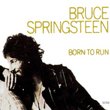

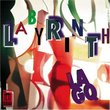

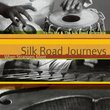
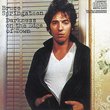
![Sly & the Family Stone - Greatest Hits [Epic]](https://nationalbookswap.com/cd//m/63/8263/18263.jpg)
